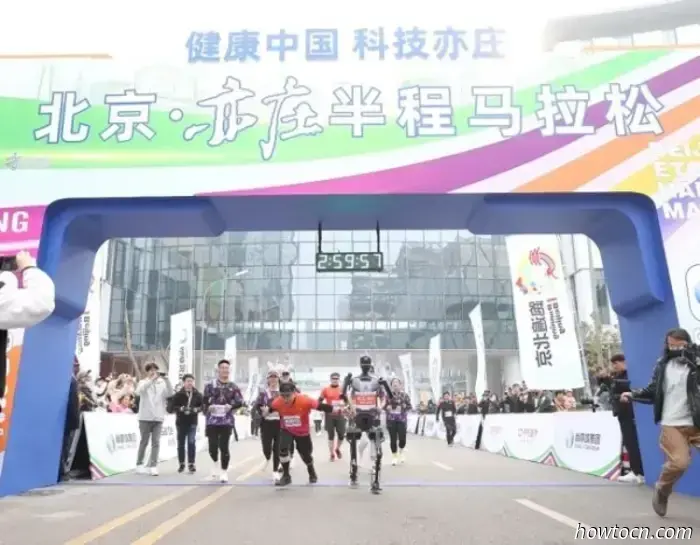
As the world quickly moves towards an unavoidable future dominated by AI and robots (personally, I feel like I’m being dragged along), some people are not just walking – they’re sprinting.
On April 13, Beijing E-Town will host the inaugural human and humanoid robot half-marathon, known as the Beijing E-Town (Yizhuang) Half Marathon, for reasons beyond just entertainment.
Beijing E-Town has held a half marathon since at least 2023, and several marathons and half marathons across the nation have incorporated robot participants. However, this is the first occasion where humanoid robots will compete alongside human runners over the full distance. Last year, during the Beijing E-Town half marathon, a robot named Tiangong, developed by the Beijing Embodied Artificial Intelligence Robotics Innovation Center (HUMANOID), ran the final 100 meters of the race to serve as a pacer and then cheered for the finishers. While there have been cases of robots participating in complete races, including a South Korean four-legged robot that finished a full marathon in just under four hours and 20 minutes, the introduction of bipedal humanoid robots as competitors this year marks a significant advancement in robotics and societal integration.
The term “Beijing E-Town” refers to both the extensive Beijing Economic-Technological Development Area, located in Daxing District, also known as the BDA, and the economic development agency established by the Beijing municipal government in 1994 to promote high-tech manufacturing in the city. The BDA consists of several subdivisions focusing on various aspects of technological or economic development. A key component is the ZGC E-Town International Robotics Industrial Park, a 250,000 square meter area within the BDA dedicated to innovation in robotics, housing over 100 robotics firms. The park launched the Beijing World of Robots in August of the previous year. Additionally, it is rumored that Beijing plans to host the World Humanoid Robot Games as a precursor to the 2025 World Robot Conference scheduled for this August.
China’s leadership in industrial manufacturing extends to AI and humanoid robotics development. The country’s industrial sector has seen substantial growth recently, with various AI and robots already being tested and utilized in factories, businesses, sports events, educational institutions, healthcare facilities, and homes. Although the background and motivations behind these initiatives are complex and extensive, addressing manual labor needs, enhancing service industry functions, advancing economic and technological output, and countering the impacts of an aging population are clearly paramount.
The mainland's robot density, which indicates the number of operational industrial robots per 10,000 employees in a region, stands at 470, putting China third after South Korea and Singapore, which operate on a much smaller scale. China has emerged as the largest adopter of industrial robots globally, accounting for over 50% of the world's robot installations in 2023. The Chinese robotics market was approximately USD 7 billion in 2024, with projections suggesting growth to between one hundred to several hundred billion USD by the 2030s.
Race Information
Although race organizers and scientists are eager to evaluate their robots, participants must adhere to all race regulations, particularly regarding the robots. Human runners and humanoid robots will have separate tracks. Robots must not pose any danger to the track, humans, or other robots. They must have a humanoid shape and be capable of walking or running on two “legs”; wheeled robots are not permitted. Height requirements dictate that robots must be between 0.5m and 1.5m (1.6ft and 6.5ft) and can be autonomous, semi-autonomous, or remotely controlled. A time limit of 3.5 hours is enforced for robot runners, with battery changes being allowed but incurring a 10-minute penalty for each change. Final scores will consider finish position and net race time, accounting for any penalties – prizes will be awarded to the top three finishers, whether human or robot, with first prize being RMB 5,000, second prize RMB 4,000, and third prize RMB 3,000, along with smaller awards for other categories.
Registration
If you’re eager to join the estimated 10,000+ human participants expected for this year’s event, there’s still time to register! Sign-ups close at 5 PM tomorrow, March 11. After registration ends, participants will be selected via a lottery, with outcomes announced in late March. Selected runners will pay an entry fee of RMB 120; participants must be at least 16 years old during the race year (2025), meaning they need to be born on or before December 31, 2009.
And if you’ve just remembered your 6-foot-tall bipedal humanoid robot named Jeff that you keep in your closet, it can also be entered into the competition by the deadline.
Interested participants can register for


On April 13, 2025, Beijing E-Town will be the venue for the world’s inaugural half-marathon featuring both humans and humanoid robots.